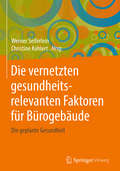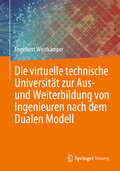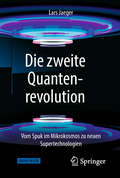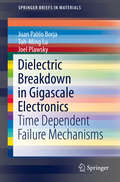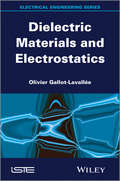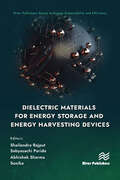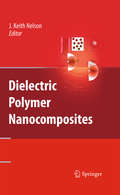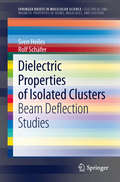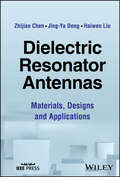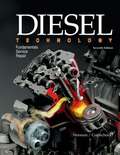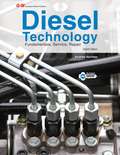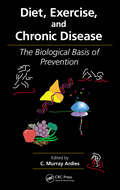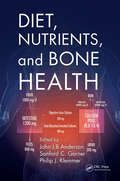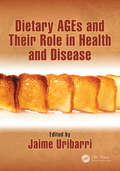- Table View
- List View
Die vernetzten gesundheitsrelevanten Faktoren für Bürogebäude: Die geplante Gesundheit
by Werner Seiferlein Christine KohlertWer im Büro arbeitet, verbringt mindestens ein Drittel seiner Lebenszeit in diesen Räumen. Die Planung von Büro- und Verwaltungsgebäuden kann daher viel zur Zufriedenheit und zum Wohlbefinden der zukünftigen Nutzer beitragen. In dem Buch werden die gesundheitsrelevanten Faktoren betrachtet, die in Büro- und Verwaltungsgebäuden auf Menschen wirken und daher in der Planung besonderes Augenmerk verdienen. Dabei orientieren sich die Autoren an einem Gesundheitsbegriff, wie ihn die Weltgesundheitsorganisation definiert: Demnach umfasst Gesundheit sowohl mentales als auch soziales und physisches Wohlbefinden und geht damit weit über die in gesetzlichen Normen und Richtlinien festgeschriebenen Faktoren hinaus.In dem Band setzen sich Architekten und Designer, Mediziner und Arbeitswissenschaftler mit allen Fragen der Innenraumgestaltung unter gesundheitsrelevanten Aspekten auseinander: Welche Rolle spielt die Farbgestaltung, welche Bedeutung haben Licht, Luft und Geräusche? Wie sieht eine bedarfsgerechte Gebäudetechnik aus und wie wird die Büroeinrichtung adäquat gestaltet? Welche medizinischen und hygienischen Aspekte sind zu beachten? Wie können Büros unter dem Aspekt der Work-Life-Balance gestaltet werden und wie verändert sich das Büro im Zuge der Digitalisierung? Das Buch dient als Leitfaden, der kapitelweise bei der Planung von gesundheitsförderlichen Büroräumen angewendet werden kann – je nach Interessenlage der Leser. Auftretende Probleme werden anhand von Beispielen diskutiert, Checklisten vereinfachen die Planung und Umsetzung. Der Leitfaden richtet sich an Bauherren, Architekten, Ingenieure, aber auch Rechtsanwälte, Psychologen und Mediziner sowie an Hochschulangehörige im Bereich Wirtschafts- und Ingenieurwissenschaften.
Die virtuelle technische Universität zur Aus- und Weiterbildung von Ingenieuren nach dem Dualen Modell
by Engelbert WestkämperNeue Wege in der technischen Aus- und Weiterbildung Dual bis zur höchsten wissenschaftlichen Promotion - Wanderung (Walz) zum Lernen bei den Besten Plattform der Virtuellen Universität Die Digitalisierung eröffnet der Aus- und Weiterbildung den Weg zur Virtuellen Universität. In diesem Buch wird der Schwerpunkt auf die Ausbildung von Ingenieuren an einer Universität gelegt, welche durch ein duales und anwendungsnahes Modell der Qualifizierung von Ingenieuren geprägt wird und einen neuen Weg zur lebensbegleitenden Weiterbildung zeigt. Es folgt der Philosophie der forschungsorientierten – Universität, die auch Ingenieure in der Praxis begleitet. Das Buch enthält Modelle zum Lernen von den Besten auf einer zeitlich begrenzten Wanderung bzw. Walz für Ingenieure.
Die zweite Quantenrevolution: Vom Spuk Im Mikrokosmos Zu Neuen Supertechnologien
by Lars Jaeger„Quantenphysik ist bizarr und komisch, und sie widerspricht komplett unserem gesunden Menschenverstand“ oder ganz einfach „Die spinnen, die Physiker“ - so oder ähnlich ist die Wahrnehmung vieler Menschen, wenn es um die Grundtheorie der modernen Physik geht. Die These dieses Buches lautet: „Quantenphysik, so bizarr und abgehoben sie erscheinen mag, ist für unser heutiges Leben die bedeutendste wissenschaftliche Theorie. Und ihr Einfluss ist bei weitem nicht an irgendein Ende gelangt. Da kommt noch einiges auf uns zu!“ Der Autor steigt dabei mitten in unser Alltagsleben ein: Sie wollen mehr über heutige und zukünftige Technologien erfahren? Dann beschäftigen Sie sich mit dem Quantencomputer oder dem Quanteninternet; Technologien, deren erste Prototypen in den letzten Jahren möglich wurden und schon sehr bald unser tägliches Leben bestimmen werden. Das Buch wird Bewusstsein schaffen für die Bedeutung der Quantenphysik heute, dabei werden auch philosophische und weltanschauliche Fragen nicht außer Acht gelassen. Am Schluss wird der Leser den heutigen Stand der Quantenphysik kennen und dabei Antwort auf Fragen finden, die Einstein, Bohr, Heisenberg und andere Physik-Genies des 20. Jahrhunderts noch nicht wussten. Mit diesem Buch erschließen sich ihm nicht nur eine Reihe ganz neuer Technologien, sondern auch die dramatischen Einflüsse der modernen Physik für das Gefüge unserer Weltanschauung.
Die-Attach Materials for High Temperature Applications in Microelectronics Packaging: Materials, Processes, Equipment, and Reliability
by Kim S. SiowThis book presents the scientific principles, processing conditions, probable failure mechanisms, and a description of reliability performance and equipment required for implementing high-temperature and lead-free die attach materials. In particular, it addresses the use of solder alloys, silver and copper sintering, and transient liquid-phase sintering. While different solder alloys have been used widely in the microelectronics industry, the implementation of sintering silver and transient liquid-phase sintering remains limited to a handful of companies. Hence, the book devotes many chapters to sintering technologies, while simultaneously providing only a cursory coverage of the more widespread techniques employing solder alloys.Addresses the differences between sintering and soldering (the current die-attach technologies), thereby comprehensively addressing principles, methods, and performance of these high-temperature die-attach materials;Emphasizes the industrial perspective, with chapters written by engineers who have hands-on experience using these technologies; Baker Hughes, Bosch and ON Semiconductor, are represented as well as materials suppliers such as Indium;Simultaneously provides the detailed science underlying these technologies by leading academic researchers in the field.
Dielectric Breakdown in Gigascale Electronics
by Toh-Ming Lu Juan Pablo Borja Joel PlawskyThis book focuses on the experimental and theoretical aspects of the time-dependent breakdown of advanced dielectric films used in gigascale electronics. Coverage includes the most important failure mechanisms for thin low-k films, new and established experimental techniques, recent advances in the area of dielectric failure, and advanced simulations/models to resolve and predict dielectric breakdown, all of which are of considerable importance for engineers and scientists working on developing and integrating present and future chip architectures. The book is specifically designed to aid scientists in assessing the reliability and robustness of electronic systems employing low-k dielectric materials such as nano-porous films. Similarly, the models presented here will help to improve current methodologies for estimating the failure of gigascale electronics at device operating conditions from accelerated lab test conditions. Numerous graphs, tables, and illustrations are included to facilitate understanding of the topics. Readers will be able to understand dielectric breakdown in thin films along with the main failure modes and characterization techniques. In addition, they will gain expertise on conventional as well as new field acceleration test models for predicting long term dielectric degradation.
Dielectric Materials and Electrostatics
by Olivier Gallot-LavalléeAn introduction to the physics of electrical insulation, this book presents the physical foundations of this discipline and the resulting applications. It is structured in two parts. The first part presents a mathematical and intuitive approach to dielectrics; various concepts, including polarization, induction, forces and losses are discussed. The second part provides readers with the keys to understanding the physics of solid, liquid and gas insulation. It comprises a phenomenological description of discharges in gas and its resulting applications. Finally, the main electrical properties of liquids and solids are presented, in order to explain the phenomena of electrical degradation, dissipation and breakdown. Contents 1. Mathematical Examination of Dielectrics2. Physical Examination of DielectricsAppendix 1. List of FiguresAppendix 2. List of SymbolsAppendix 3. List of Useful ValuesAppendix 4. Reminder about Dielectric SpectroscopyAppendix 5. Reminder about Transitory Currents
Dielectric Materials for Capacitive Energy Storage (Emerging Materials and Technologies)
by Haibo Zhang Hua TanDue to growing energy demands, the development of high-energy storage density dielectric materials for energy storage capacitors has become a top priority. Dielectric Materials for Capacitive Energy Storage focuses on the research and application of dielectric materials for energy storage capacitors. It provides a detailed summary of dielectric properties and polarization mechanism of dielectric materials and analyzes several international cases based on the latest research progress.• Explains advantages and development potential of dielectric capacitors.• Discusses energy storage principles of dielectric materials as well as effects of polarization and breakdown mechanisms on energy storage performance.• Summarizes achievements and progress of inorganic and organic dielectric materials as well as multidimensional composites.• Details applications and features international case studies.• Offers unique insights into existing issues and forecasts for future research priorities.With its summary and large-scale analysis of the fields related to dielectric energy storage, this book will benefit scholars, researchers, and advanced students in materials, electrical, chemical, and other areas of engineering working on capacitors and energy storage.
Dielectric Materials for Electrical Engineering
by Juan Martinez-VegaPart 1 is particularly concerned with physical properties, electrical ageing and modeling with topics such as the physics of charged dielectric materials, conduction mechanisms, dielectric relaxation, space charge, electric ageing and life end models and dielectric experimental characterization. Part 2 concerns some applications specific to dielectric materials: insulating oils for transformers, electrorheological fluids, electrolytic capacitors, ionic membranes, photovoltaic conversion, dielectric thermal control coatings for geostationary satellites, plastics recycling and piezoelectric polymers.
Dielectric Materials for Energy Storage and Energy Harvesting Devices (River Publishers Series in Energy Sustainability and Efficiency)
by Abhishek Sharma Shailendra Rajput Sabyasachi ParidaAs the demand for energy harvesting and storage devices grows, this book will be valuable for researchers to learn about the most current achievements in this sector. Sustainable development systems are centered on three pillars: economic development, environmental stewardship, and social. One of the ideas established to achieve balance between these pillars is to minimize the usage of nonrenewable energy sources. Harvesting energy from the surrounding environment and converting it into electrical power is one viable solution to this problem. In recent years, there has been a surge in the development of new energy generation technologies such as solar, wind, and thermal energy to replace fossil fuel energy supplies with cleaner renewable ones. Energy harvesting systems have emerged as a key study topic and are rapidly expanding.
Dielectric Polymer Nanocomposites
by J. Keith NelsonDielectric Polymer Nanocomposites provides the first in-depth discussion of nano-dielectrics, an emerging and fast moving topic in electrical insulation. The text begins with an overview of the background, principles and promise of nanodielectrics, followed by a discussion of the processing of nanocomposites and then proceeds with special considerations of clay based processes, mechanical, thermal and electric properties and surface properties as well as erosion resistance. Carbon nanotubes are discussed as a means of creation of non linear conductivity, the text concludes with a industrial applications perspective.
Dielectric Properties of Isolated Clusters
by Rolf Schäfer Sven HeilesA broad range of state-of-the-art methods to determine properties of clusters are presented. The experimental setup and underlying physical concepts of these experiments are described. Furthermore, existing theoretical models to explain the experimental observations are introduced and the possibility to deduce structural information from measurements of dielectric properties is discussed. Additional case studies are presented in the book to emphasize the possibilities but also drawbacks of the methods.
Dielectric Resonator Antennas: Materials, Designs and Applications
by Haiwen Liu Zhijiao Chen Jing-Ya DengDielectric Resonator Antennas A detailed guide to dielectric-based techniques for antenna array design and construction Dielectric designs, which transmit electricity without conducting it, have in recent decades been increasingly incorporated into antenna arrays. The resulting Dielectric Resonator Antennas (DRAs) provide significant benefits over metal antennas, avoiding conduction loss and increasing efficiency. Dielectric elements can also be incorporated into metal antennas to improve performance. Dielectric Resonator Antennas provides an introduction to dielectric-based techniques for manufacturing antenna arrays. It supplies guidelines for identifying dielectric antenna designs (as opposed to metal ones), describes recent developments in dielectric antenna technology, and points toward potential areas of future growth and development. Readers will also find: Cutting-edge DRA applications in microwave and millimeter-wave communications Detailed discussion of array types including wideband, high-gain, high efficiency, and more Instructions for fabricating dielectric antenna arrays and assessing tolerance levels Dielectric Resonator Antennas is ideal for researchers and students in electrical engineering, as well as for engineers and others working in wireless communications.
Dielectrics in Electric Fields: Tables, Atoms, and Molecules
by Gorur Govinda RajuDielectrics in Electric Fields explores the influence of electric fields on dielectric—i.e., non-conducting or insulating—materials, examining the distinctive behaviors of these materials through well-established principles of physics and engineering. <p><P>Featuring five new chapters, nearly 200 new figures, and more than 800 new citations, this fully updated and significantly expanded Second Edition: <li>Analyzes inorganic substances with real-life applications in harsh working conditions such as outdoor, nuclear, and space environments <li>Introduces methods for measuring dielectric properties at microwave frequencies, presenting results obtained for specific materials <li>Discusses the application of dielectric theory in allied fields such as corrosion studies, civil engineering, and health sciences <li>Combines in one chapter coverage of electrical breakdown in gases with breakdown in micrometric gaps <li>Offers extensive coverage of electron energy distribution—essential knowledge required for the application of plasma sciences in medical science <li>Delivers a detailed review of breakdown in liquids, along with an overview of electron mobility, providing a clear understanding of breakdown phenomena <li>Explains breakdown in solid dielectrics such as single crystals, polycrystalline and amorphous states, thin films, and powders compressed to form pellets <li>Addresses the latest advances in dielectric theory and research, including cutting-edge nanodielectric materials and their practical applications <li>Blends early classical papers that laid the foundation for much of the dielectric theory with more recent work <P><P>The author has drawn from more than 55 years of research studies and experience in the areas of high-voltage engineering, power systems, and dielectric materials and systems to supply both aspiring and practicing engineers with a comprehensive, authoritative source for up-to-date information on dielectrics in electric fields.
Dienstleistungen für die energieeffiziente Stadt
by Britta Oertel Michael KnollFörderung und Umsetzung von Energieeffizienz und Klimaschutz zählen zu den vorrangigen Aufgaben von Städten und Gemeinden. Innovative Dienstleistungen leisten hierzu einen bedeutenden Beitrag. Der Sammelband präsentiert aktuelle Umsetzungskonzepte aus 15 Städten und bietet einen Überblick über neue Erkenntnisse aus der Dienstleistungsforschung im Hinblick auf Energieeffizienz. Die Beiträge anerkannter Wissenschaftler richten sich an alle, die sich dieses interdisziplinäre Forschungs- und Handlungsfeld erschließen möchten.
Diesel Engine Operations with Alternative Fuels
by Rafał LongwicDiesel Engine Operations with Alternative Fuels presents the results of a study that analyzes selected parameters of the combustion process in a diesel engine when fueled with alternative fuels. It discusses the use of a unique test stand consisting of a motor vehicle with a diesel engine adapted to run on different fuels: liquid and gas.Intending to carry out the process of indicating the engine and measuring exhaust gas toxicity under near real conditions, the book demonstrates the implementation of a Worldwide harmonized Light vehicles Test Procedure (WLTP test). It shares research that seeks alternative fuels to power the diesel engine, including diesel and hydrogen, rapeseed oil with n-hexane and hydrogen, rapeseed oil with n-hexane, rapeseed oil and propane-butane gas, and rapeseed oil with n-hexane and propane-butane gas.The book will interest academic researchers and graduate students studying alternative fuels, vehicle operations, and engine operations.
Diesel Technology: Fundamentals, Service, Repair
by Andrew Norman John A. CorinchockDiesel Technology covers the construction, operation, service, and repair of two- and four-stroke diesel engines. This textbook details developments in engine control computers, fuel management systems, and emission control systems. Content relates to on- and off-road vehicles, as well as marine, agricultural, and industrial applications. Diesel Technology is a valuable resource for anyone involved in the service and repair of diesel engines, including those preparing for the ASE Medium/Heavy Truck Test T2Diesel Engines, Test T6Electrical/Electronic Systems, and Test T8Preventive Maintenance Inspection (PMI). -Includes the latest standards for diesel engine oils, ultra-low sulfur fuel, and biodiesel fuel. -Written in a clear, logical, and interesting manner, making it easy to understand complex topics. -Contains a detailed chapter on preventive maintenance and troubleshooting.
Diesel Technology: Fundamentals, Service, Repair (Eighth Edition)
by Andrew Norman John A. CorinchockDiesel Technology covers the design, construction, operation, diagnosis, service, and repair of both mobile and stationary diesel engines. This textbook details developments in engine control computers, fuel management systems, and emission control systems. Diesel Technology is a valuable resource for anyone involved in the service and repair of diesel engines, as well as those preparing for the ASE Medium/Heavy Truck Test T2 - Diesel Engines, Test T6 - Electrical/Electronic Systems, and Test T8 - Preventive Maintenance Inspection (PMI).
Diesel – eine sachliche Bewertung der aktuellen Debatte: Technische Aspekte und Potenziale zur Emissionsreduzierung (essentials)
by Thomas KochThomas Koch zeigt die Vorteile und Potenziale von Dieselmotoren auf, die seit wenigen Jahren auch in der breiten Öffentlichkeit sehr kontrovers betrachtet werden. Insbesondere werden die technischen Gründe für die Auslegung der Motoren und Abgasnachbehandlungssysteme vorgestellt. Der Autor plädiert für eine strenge, warnt jedoch zugleich vor einer überzogenen weiteren Regulierung der Dieselemissionen. Die neue RDE-Gesetzgebung ist im Grunde die strengste weltweit, da unter unbekannten Fahrbedingungen eine Emissionserfüllung sichergestellt werden muss. Sie sollte daher ausreichend sein. Bei der neuesten Generation von Dieselmotoren kann das NOx-Problem als technisch gelöst betrachtet werden. Daher kann dieser Motor mit seinen positiven Eigenschaften wie geringsten Emissionen, einer hohen Leistung, einem ansprechenden Drehmoment und mittlerweile sehr eindrücklicher Komfortverbesserung weiterhin als zukunftsweisende Technologie betrachtet werden.Der Autor Prof. Dr. sc. techn. Thomas Koch ist Leiter des Instituts für Kolbenmaschinen am Karlsruher Institut für Technologie (KIT) und stellvertretender Vorsitzender der wissenschaftlichen Gesellschaft für Kraftfahrzeug- und Motorentechnik e.V. (WKM).
Diet Nutrition and Immunity
by R. Armour ForseThis book was written to provide a thorough overview of clinical nutrition and immunology to allow the reader to become knowledgeable in this evolving and complex area of medicine. The reader, whether a clinician, student, teacher, or researcher, will find this book comprehensive and up to date.The disease-specific chapters have been written to focus attention on novel approaches to nutrient-immune system interactions that affect specific diseases. This includes the identification of immunologic actions that can be influenced by nutrition. Specific nutrient chapters were written by experienced investigators to provide the reader with an understanding of the current role of nutrients in the immune system with both clinical and research applications. Throughout the book, the authors actively emphasize new frontiers for research and practical use of new findings in the fields of nutritional medicine and nutritional pharmacology.
Diet Quality: An Evidence-Based Approach, Volume 1
by Victor R. Preedy Vinood B. Patel Lan-Anh HunterDiet quality is a broad term that encapsulates both perceived and actual practices, personal preferences and cultural diversity. Measuring dietary quality can be problematic and includes investigating food types, the number or size of portions or their frequency. Diet quality may also be related to the type of food being ingested, snacking and other eating habits. Manufactured beverages and fast food may also be included as well as microbiological quality and attempts to improve single food items such as meats or vegetables. In this book, Diet Quality: An Evidence-Based Approach, Volume 1 all of the major facets of diet quality in relation to health outcomes are covered. This important new text includes methods for determining diet quality while adopting a holistic approach to impart information on the major areas of concern or knowledge. Chapters link in measurable indices of health such as obesity, pregnancy outcomes, cancer and cancer outcomes, and mortality. This book represents a diverse set of subject matters and seeks to fill a gap in the literature at a time when there is an increasing awareness that well being is associated with the qualitative nature of diets. Contributors are authors of international and national standing and emerging fields of science are incorporated. Diet Quality: An Evidence-Based Approach, Volume 1 is a useful new text designed for nutritionists, dietitians, clinicians, epidemiologist, policy makers and health care professionals of various disciplines.
Diet for a Sustainable Ecosystem: The Science for Recovering the Health of the Chesapeake Bay and its People (Estuaries of the World)
by Benjamin E. CukerThis book explores a specific ecosystem in depth, in order to weave a story built on place and history. It incorporates the theme of a journey to help reveal the environment-human-health-food system-problem. While drawing on a historical approach stretching back to the American colonial era, it also incorporates more contemporary scientific findings. By crafting its story around a specific place, the book makes it easier for readers to relate to the content, and to subsequently use what they learn to better understand the role of food systems at the global scale.
Diet, Exercise, and Chronic Disease: The Biological Basis of Prevention
by C. Murray ArdiesExercise and diet are key factors in the etiology and prevention of chronic disease. While most books on chronic disease have a decided clinical approach, Diet, Exercise, and Chronic Disease: The Biological Basis of Prevention brings together the latest cellular- and molecular-based research on the etiology of chronic diseases and the impact of var
Diet, Nutrients, and Bone Health
by Sanford C. Garner Philip J. Klemmer John J.B. AndersonPresenting recent advancements in research findings and the resulting new schools of thought on the physiology of human bone, this comprehensive reference examines information on dietary pattern and specific nutrients in bone health. Written by experts in the areas of nutrition, bone function, and medicine, chapters include research on a variety of
Dietary AGEs and Their Role in Health and Disease
by Jaime UribarriOf the many dietary factors associated with inflammation and oxidative stress, a specific group are food-derived pro-inflammatory and pro-oxidant compounds, so-called advanced glycation end products (AGEs). While AGEs have been recognized as factors in the pathogenesis of diabetic complications, the importance of AGEs of dietary origin as a factor in human disease is of more recent concern. This book presents data from the past two decades on the role of AGEs in causing chronic disease. It starts by defining the compounds passing through all the clinical diseases that have been associated with them and finishes by offering different therapeutic options to deal with the problem.
Dietary Fiber and Health
by Susan S. Cho Nelson AlmeidaAdequate fiber in the diet is essential for maintaining gastrointestinal and cardiovascular health and for weight management and glycemic control. But a majority of people in developed countries fall short of their recommended daily intake. Designed for product developers, nutritionists, dietitians, and regulatory agencies, Dietary Fiber and Health
